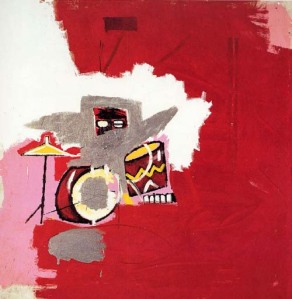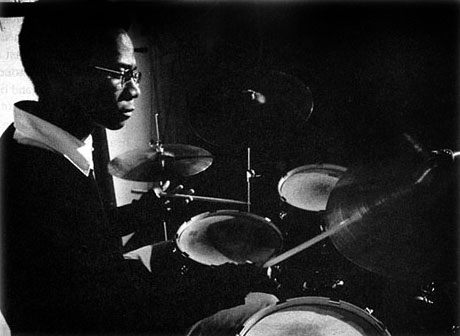You are currently browsing the tag archive for the ‘Creativity’ tag.
This is a follow-up to last year’s post on the creative process. Specifically, I’ve got some thoughts about the 1st stage of the process… the “ideas” stage. This stage is most deeply studied in the realm of improvised music, and so I’m thinking mainly of that environment as I write this.
In educational settings, the analogy is often used that improvising is like exploring a room. Attempting to discover new improvisational ideas is like becoming familiar with a room that you haven’t spent time in before. You look all around at the various parts, you study them, and you try to really look closely. The goal is to get to know everything about the room – all the details. The more aware you are of what the room contains, the more you will find the room to be useful.
This analogy makes sense to me in the world of music improvisation and creative ideas, but I think the reality of the situation is much bigger than the analogy suggests. For me, improvisational exploration has shown ideas to be not just rooms, but also hallways leading to different rooms.
For example, I spent a long time exploring (in jazz) the idea that the kick and the snare can compose two-tone melodies/lines/phrases/whatever underneath a swing ride pattern and a hihat foot accent on the backbeats. As I explored this “room,” I found that the various subdivisions of notes (triplet 8ths, triplet 16ths, straight 8ths, etc…) provided a vast vocabulary for composing kick/snare lines. I also discovered polyrhythms, unsymmetrical groupings in general, and accents. These discoveries really opened up my mind to the mountain of possibilities in the kick/snare comping, and had a huge effect on my playing. I felt like I was really starting to understand the “room” I was in and how it could serve my music making.
And then, my teacher told me about using my hihat foot in the comping (and not just accenting the backbeats), which turned the two-tone composing into three-tone composing. This totally blew my mind. I suppose you could say, in line with the room analogy, that I found a corner of the room that I hadn’t yet explored. “Oh hey… look over there… I’ve been in this room all along and I never knew THAT was in here.” But honestly, it felt more like I had found a completely different room. EVERYTHING changed. It was like I had discovered a trap door, and opened it, and found a new room altogether, whose existence I had never even considered. And this new room was bigger than the first one… way bigger. Tons to explore in the new room, and best of all, there were 3 or 4 additional doors in the new room that were visible. Not hidden trap doors either… obvious ones. But these were doors that I knew I shouldn’t open yet, because I needed to spend a little time just acclimating to the new room itself before I went any further.
Anyway, it was a cool experience, and it’s happened a handful of other times with improvising and creative exploration. So at this point, I no longer view improvising as exploring a room, but rather a whole house. I have no idea how big the house is, or what the layout is like. Some rooms are like hallways, with lots of doors to other rooms. Some rooms are like closets, where there is only one way into them and they are seemingly quite small. But in all this each room has something to offer. I know there are rooms that I’ve discovered that I really didn’t take the time to fully explore, and I know there are rooms that get a LOT more use than they really deserve.
I think this is ultimately why artists can be so different from each other creatively. To take the analogy further, I see traditionally-minded musicians as artists who tend to put emphasis on FULLY exploring every nook and cranny of the main/common/obvious room. The idea is that this room is so big and functional that you just don’t need any other rooms. But the more progressive guys see a lot of reasons to explore the immediate surrounding rooms, and yet still base operations out of the main room. And then there’s the crazy avant-garde guy who just heads straight for the farthest corner of the attic and sets up shop in a spot where almost no one can even find him. Along these lines…. early on in the life of this blog I wrote a post about programmers, and how electronic musicians have some almost super-natural exploring capabilities, because they don’t have to actually perform (physically execute) their ideas.
All of this to say… the “ideas” stage of the creative process is a big deal. The degree to which you explore not only the room you’re in, but the house itself – to this degree you will find fuel for ideas in your improvising. Don’t assume that the initial appearance of the room reveals everything that’s there to be found. There might be one of those revolving bookcases if you look close enough. And then… look out.
Man… Brian Blade is definitely one of my favorite drummers right now. He has so much control, his ideas are so musical, and his groove is so comfortable. Love it.
Brian Blade is on my mind today because I’ve been listening to Danial Lanois’ “Shine” quite a bit. Blade just destroys that record. His feel, his comfort and vocabulary… unbelievable. The album is a singer-songwriter style, and so Blade is of course playing appropriately within that realm. BUT, he is also a widely respected jazz player. THAT is the main point of this post.
I’ve had more than a few musicians whom I respect tell me that my best bet is to pigeon-hole my efforts on the drums into one genre/sound, and just try to make that as killing as I can. I understand the logic: don’t waste time trying to improve your weaknesses, just focus on making your strengths even stronger and soon you will be the only fish in the pond that anyone wants to work with, when it comes to those strengths. This idea is big in the business world, and it makes sense to a degree… but I’m not sure it applies to Art.
I studied jazz music extensively in college, and I’ve also spent a lot of time in pop/rock settings. In fact, I’ve done quite a bit of gospel lately, and some alt-country, and even some electronica/drum-n-bass. Therefore, I’m obviously in danger of spreading myself too thin according to the “ignore-your-weakness-promote-your-strength” mantra, but I don’t see it that way. I feel like I have learned concepts in studying jazz that I can apply to rock… things that make my rock playing different from another rock drummer who has never studied jazz. Conversely, I can bring rock elements into my jazz that sound hopefully make my jazz playing unique. Of course, I have to have a solid understanding of the difference between rock and jazz, but having a presence in both worlds is a challenge that I enjoy taking on.
Actually, I believe learning about and participating in many different styles/genres is an essential element to feeding creativity in your playing. I guess I just disagree with the advice I’ve been given. Maybe I’ll recant in a few years when I am wiser, but for now, I encourage every musician who reads this blog to surround yourself with as many different-sounding records as you can find, and soak them all in.
 Listen, I know this is my 3rd post in one hour, but I just started this blog today so I feel like I need to fill it up a little. Actually, I think I’ve figured out how to add pictures to the posts so I’m going to try it.
Listen, I know this is my 3rd post in one hour, but I just started this blog today so I feel like I need to fill it up a little. Actually, I think I’ve figured out how to add pictures to the posts so I’m going to try it.
This is a work by Jean-Michel Basquiat, an 80’s Neo-Expressionist from Manhattan. It’s titled “Max Roach,” after the Jazz founding-father and drumming legend of the same name. Roach had a massive influence on the evolution of jazz drumming, and Basquait just nails the essence of Roach’s sound in depicting him as cloud hovering behind the drumset.
Basquiat was heavily influenced by Jazz and Jazz musicians throughout his career. If a painter (visual) can draw inspiration from a musician (audio), then that transaction can definitely take place the other direction as well. In college I studied with the internationally-acclaimed, avante-garde drummer David King. Dave was CONSTANTLY referencing paintings and films in the lessons (which is where I first learned about Basquiat), which didn’t make much sense to me at first, but over time I began to see the connection that he was drawing on – the connection that exists between all forms of art. Creativity is art’s essence, and the creative process is so much bigger than any one genre of art (or music, for that matter).
More on this to come…


Recent Comments